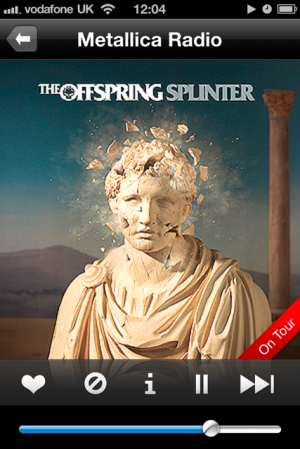Mobile Music Applications Analysis. Part 1
IIn the first post in this series, Mobile Music App Revenue & Predictions, we talked about how apps, streaming and ringtones were earning the mobile industry more than $15 billion in 2011, according to stats published by Midem.
With revenue in 2014 predicted to be more than $25 billion, we decided to take a closer look at some of the most successful mobile music apps to understand the secret of their success – and why they’re making so much money.
Spotify
Music streaming aways seemed like a distant, implausible concept before it arrived.

Spotify app's Playlists screen
Those in doubt said consumers wanted to personally own anything they paid for. Of course, the same people were saying that digital music stores like iTunes wouldn’t take off either, because consumers wanted to touch and feel products they paid for.
Today, music streaming is a reality – and in the era of smartphones, music streaming is not only a reality, but a solution to having lower storage in mobile devices than our desktop computers.
Spotify was already the grand master of music streaming in Europe, and in July it finally launched in the US. According to All Things D, they’ve already racked up over 1 million US users, with 175,000 paying $5 for ad-free desktop use or $10 to stream on mobiles.
The company say that 90% of these users are paying the higher tier, earning a tidy $245,000 per month from the US alone. And that’s after only one month of limited invite-only access.
The current European user base is unclear, but last September they passed the 10 million user mark, with around 750,000 subscribers.
Mobile operators are keen to tap in to Spotify’s obvious appeal. With a long term exclusive partnership, Swedish mobile network Teliasonera offer Spotify Premium for around €3/month – a 71% discount from a regular subscription – encouraging customers to sign up for longer 24 month contracts.
Teliasonera say this has brought them more than half of their new customer base, with just as many saying they’re less likely to leave the company because of the Spotify deal.
Soundcloud
Soundcloud has become the de facto platform for sharing and storing audio online.

Soundcloud app
Speaking to Ultimate Guitar, Soundcloud business developer David Adams said their mobile app helps bring people outside of traditional audio circles into the recording arena, thanks to their instant record-and-upload button: “It’s a great tool to lower the barrier for anyone to willing to record, and opens a new world of personal expression and collaboration.” He says that both their iOS and Android apps have over 1 million users each.
The mobile record button is a powerful feature, but it’s when the creative folk in the wild get their hands on it that the app becomes particularly interesting. UK comedian Richard Herring has been recording a daily audio blog, people are documenting the sounds of their cities as seen on Sounds of Tampa Bay, and the musician Imogen Heap took audio submissions recorded on the app by fans (including the heartbeat of a baby, and eggs dropping into a pan), before mixing them into her own music.
In a similar example, electronic artist Tim Exile remixed fan submissions live, with clips coming in from around the world mid-performance:
Besides the ability to record on location, you can instantly stream any tracks shared by your friends and favourite musicians, or search their mammoth archive of online audio.
Soundcloud is free until you store more than two hours of audio, and a series of premium accounts from Lite (€29/$42) to to Pro Plus (€500/$439) unlock features like better audio widgets, more storage, and detailed stats.
Even their free package is a game-changing service, and with their mobile app they help build an audio community who depend on and appreciate their service. This helps build their subscription base, because the amateur musicians on a free package need more space eventually, bigger labels can’t ignore the growing soundcloud listenership, and news sites love posting new music streams found on Soundcloud because of their pretty embeddable widgets.
Last.fm
In some ways, Last.fm was ahead of its time. It began as the open-source Audioscrobbler, which tagged any music you played to the last.fm website, allowing you to browse your listening history and see a personal ‘chart’ of your favourite music.
Once it knew what music you liked, it could recommend similar artists, and even notify you when your favourite bands were touring nearby. Their automated ‘recommendation radio’ remains one of the best ways to find great music.
But when the innovative Last.fm founders Martin Stiksel, Felix Miller and Richard Jones left in 2009, the site appeared to lose its innovative core and was left behind in the mobile app revolution.

Last.fm app
Today, the mobile version of Last.fm offers the same radio and gig list functionality as the website, albeit in a smoother interface. Having their recommendation radio for free seemed too good to be true – which is probably why they eventually slapped a subscription price of $3/month on it in February.
In our humble opinion, their automated radio is far superior to Spotify, and much cheaper – but you can’t browse their catalog and make playlists to save for the future.
Next time we’ll be looking at how Shazam gets a cut from 300,000 music sales per day, how you can build an app for your band with Mobile Roadie, how Songkick tells you what gigs you’ll love, and how FourTrack helps pros record music on the go.
Do you use a great mobile music app that we haven’t mentioned? Which are your favourites, and which convince you to part with your money?
Written by Tom Davenport. The article was originally published on Ultimate-Guitar.com.


Comments